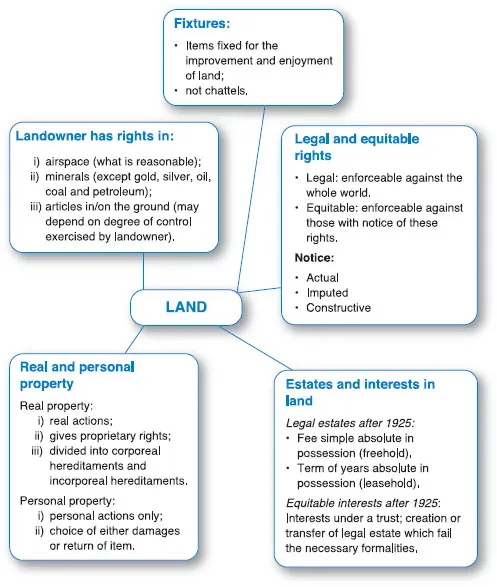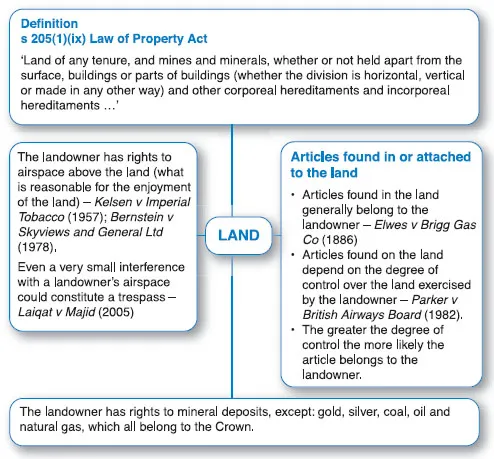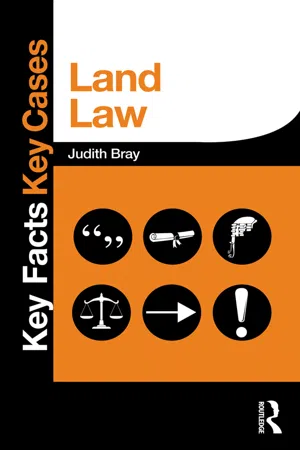eBook - ePub
Land Law
About this book
Key Facts Key Cases: Land Law will ensure you grasp the main concepts of your Land Law module with ease. This book explains the facts and associated case law for:
-
- The definition of land
- The registered land system
- Co-ownership
- Express, resulting and constructive trusts in land
- Leases
- Key rights in land such as easements and covenants
- Mortgages
- Proprietary estoppel and licences.
- Adverse possession
Key Facts Key Cases is the essential series for anyone studying law at LLB, postgraduate and conversion courses. The series provides the simplest and most effective way to absorb and retain all of the material essential for passing your exams. Each chapter includes:
-
- diagrams at the start of chapters to summarise key points
- structured headings and numbered points to allow for clear recall of the essential points
- charts and tables to break down more complex information
Chapters are also supported by a Key Cases section which provides the simplest and most effective way to absorb and memorise essential cases needed for exam success.
-
- Essential and leading cases are explained
- The style, layout and explanations are user friendly
- Cases are broken down into key components by use of a clear system of symbols for quick and easy visual recognition
Frequently asked questions
Yes, you can cancel anytime from the Subscription tab in your account settings on the Perlego website. Your subscription will stay active until the end of your current billing period. Learn how to cancel your subscription.
No, books cannot be downloaded as external files, such as PDFs, for use outside of Perlego. However, you can download books within the Perlego app for offline reading on mobile or tablet. Learn more here.
Perlego offers two plans: Essential and Complete
- Essential is ideal for learners and professionals who enjoy exploring a wide range of subjects. Access the Essential Library with 800,000+ trusted titles and best-sellers across business, personal growth, and the humanities. Includes unlimited reading time and Standard Read Aloud voice.
- Complete: Perfect for advanced learners and researchers needing full, unrestricted access. Unlock 1.4M+ books across hundreds of subjects, including academic and specialized titles. The Complete Plan also includes advanced features like Premium Read Aloud and Research Assistant.
We are an online textbook subscription service, where you can get access to an entire online library for less than the price of a single book per month. With over 1 million books across 1000+ topics, we’ve got you covered! Learn more here.
Look out for the read-aloud symbol on your next book to see if you can listen to it. The read-aloud tool reads text aloud for you, highlighting the text as it is being read. You can pause it, speed it up and slow it down. Learn more here.
Yes! You can use the Perlego app on both iOS or Android devices to read anytime, anywhere — even offline. Perfect for commutes or when you’re on the go.
Please note we cannot support devices running on iOS 13 and Android 7 or earlier. Learn more about using the app.
Please note we cannot support devices running on iOS 13 and Android 7 or earlier. Learn more about using the app.
Yes, you can access Land Law by Judith Bray in PDF and/or ePUB format, as well as other popular books in Law & Law Theory & Practice. We have over one million books available in our catalogue for you to explore.
Information
1
Land


1 Land law deals with the legal relationship between land and the owner of that land.
2 Many different people can have competing claims in respect of the same piece of land.
3 The interests of owners of neighbouring land often affect the landowner’s enjoyment of his own land, so land should not be seen in isolation.
4 The competing interests of different landowners become more significant as more land is taken into residential ownership.
5 Ownership of land therefore comprises not only rights one may have over one’s own land, but also rights one may have over a neighbour’s land. Such rights may include the right to use a neighbour’s land in a particular way or to prevent a particular use a neighbour may wish to make of the land.


‘Whoever owns the soil owns everything up to the heavens and down to the depths of the earth’ (Cuius est solum, eius est usque ad coelum et ad inferos).
A landowner has no rights to enter the land of his neighbour in order to carry out repairs to his own property (John Trenberth Ltd v National Westminster Bank (1979)).
The Access to Neighbouring Land Act 1992 allows a landowner the right to make an application to court for an order allowing access for specified repairs. The terms of the order are very strictly limited to whatever access is necessary for the essential repairs to be carried out.
The ground immediately below the surface is owned by the landowner. If there is a cellar or open space below the land, it is owned by the landowner irrespective of whether he is aware of it or not (Grigsby v Melville [1974]).

1 Property is divided into real and personal property.
2 Real property mainly comprises land and is property that can be recovered by a real action, allowing a claimant to recover the property itself.
3 Personal property is property that can only be recovered by a personal action, allowing the defendant a choice between the return of the item or paying a sum in damages.
4 Historically, leaseholds were treated as personal property and could only be recovered by personal action (i.e. the claimant might have to be satisfied with damages only).
5 Today, the important issue is whether a right over land is personal or proprietary.
6 A proprietary right is a right in the land itself, which can be binding on a third-party purchaser.
7 A lease is now defined as a proprietary right in land.
8 A personal right is a right against another person and cannot bind a third party (e.g. a bare licence only gives the licensee the right to remain on the land until the licence is revoked by the licensor).
1.3.1 Real property
1 An estate in land is a right over land for a period of time.
2 Under the Law of Property Act (LPA) 1925 s 1(1) there are only two legal estates in land: leasehold and freehold.
3 An estate in land can also be called real property.
4 Land includes rights called incorporeal and corporeal hereditaments.
5 Hereditaments are rights in land that can be inherited and so can pass under a will or an intestacy.
6 Corporeal hereditaments are physical objects (e.g. land and anything attached to it, such as buildings, trees and minerals).
7 Incorporeal hereditaments are rights in land that are not physical things (e.g. easements and profits), but can be very valuable.

1 Historically:


Table of contents
- Cover
- Half Title
- Title Page
- Copyright Page
- Table of Contents
- Preface
- Table of Cases
- Chapter 1: Land
- Chapter 2: Transfer and Creation of Rights in Land
- Chapter 3: The 1925 Legislation and the Transfer of Rights in Unregistered Land
- Chapter 4: Registration of Title
- Chapter 5: Informal Creation of Rights in Land
- Chapter 6: Proprietary Estoppel
- Chapter 7: Licences in Land
- Chapter 8: Co-Ownership
- Chapter 9: Co-Ownership of Land After 1996: Trusts of Land
- Chapter 10: Easements
- Chapter 11: Covenants
- Chapter 12: Mortgages
- Chapter 13: Leases
- Chapter 14: Adverse Possession
- Index
